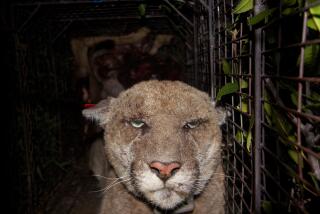Animal Activists Seek Ban on Trapping
- Share via
OLYMPIA, Wash. — Since the days of Captain James Cook’s arrival in the 1770s, fur traders have set traps throughout the Pacific Northwest and sold the pelts of wild animals to markets around the world.
But animal-rights activists say the practice of catching and killing beavers, raccoons and other creatures has no place in the modern world.
They are circulating proposed ballot initiatives in Washington and Oregon that would virtually outlaw most “body-gripping” traps and ban commercial trade in pelts.
“It’s an especially cruel practice,” said Lisa Wathne, a Seattle-based representative of the Humane Society of the United States. She is spearheading the campaign for Initiative 713 in Washington.
“If anyone has ever seen a photograph of an animal in a trap, they don’t forget it. Lots of people who sign [the petition] had their pets caught in traps.”
Trapping Seen as ‘Wildlife Management’
Hunters say I-713 and an identical proposal in Oregon, Initiative 81, are the latest examples of extremists making an end-run around policymakers and using the ballot box to push an anti-hunting agenda.
Hunting policy should be set by experts, not the same activists who pushed successful initiatives in recent years to restrict cougar and bear hunting, they say.
“These animals need to be managed professionally and scientifically for their well-being and safety,” said B.J. Thorniley, a leader of the 400-member Washington Trappers Assn.
Both Washington and Oregon allow the trapping of such animals as badger, beaver, bobcat, coyote, fox, marten, muskrat, nutria, raccoon, skunk and weasel. Some are subject to hunting seasons that last several months, while others can be trapped year-round by licensed trappers.
Much of the year-round work involves responding to nuisance complaints from landowners battling flooding problems caused by beaver dams, and from ranchers trying to protect cattle from coyotes and bobcats.
Wildlife agencies in both states cannot take positions on ballot measures. But both agencies say trapping is an important part of their wildlife-management strategies.
Trapping reduces or prevents damage to agricultural crops and property, protects public health by tracking and reducing the threat of rabies and other diseases, and helps restore endangered species by removing predators, they say.
“We’re trying to keep animals out of trouble, out of conflict, and balanced with habitat. As habitats shrink, that becomes much more important,” said Tom Keegan, who manages the Washington Department of Fish and Wildlife’s trapping program.
But the Humane Society and other animal groups say some traps serve as “land mines” that indiscriminately kill and maim wildlife and pets.
Their initiatives would ban steel-jaw traps that snap over an animal’s leg, so-called Conibear traps that whack an animal in the back of the head, wire snares and two kinds of poison. Special 30-day permits could be issued to use the traps if all other efforts to remove a problem animal failed.
Activists on the campaign trail are armed with grisly photographs, mostly taken in other states. Several pictures show dogs with bloody paws, and one shows a dog with its face gruesomely twisted in a trap.
Supporters already have had success in Arizona, California, Colorado and Massachusetts, where voters have banned or restricted the use of traps in recent years.
Trappers, who earn about $3 for muskrat and weasel pelts and $23 for beaver, point out that Mother Nature can kill in far more cruel ways if animal populations are allowed to grow unchecked.
“Animals die of disease and starvation because habitat can only sustain so many,” says Thorniley, who lives in Nordland, Wash., and trapped for nearly 30 years.
Many Out-of-State Donations to Campaign
Industry defenders point to Massachusetts as an example of what could happen if either initiative is approved.
Since voters approved a 1996 referendum that restricted the use of traps, state officials say the population of beavers has increased from 15,000 to nearly 70,000. As a result, Massachusetts lawmakers are struggling to respond to flooding caused by beaver dams that has inundated roads, cellars, septic systems and public water systems.
Trapper Ken Koski of Shelton, Wash., said traps have evolved in recent years to accommodate concerns about the humane treatment of animals.
Traps that kill are designed to do so quickly, either by a quick blow to the head or holding an animal underwater until it drowns, he said. Modern traps that are designed to grab and hold animals on land have gaps between the jaws and padding to keep from breaking skin and bones.
Foes of the initiatives say animal-rights groups are deceiving voters by including two kinds of poison--a lethal concoction known as Compound 1080 and sodium cyanide.
Use of Compound 1080, or sodium fluoroacetate, is already banned. Sodium cyanide is authorized for use only by federal wildlife agents to kill predators that prey on livestock, according to Washington state wildlife officials.
Foes also complain that so far most of the money contributed to the initiative campaign has come from animal-rights groups in California, New York, Massachusetts and Washington, D.C.
Wathne, sponsor of the Washington state measure, makes no apologies for the out-of-state donations since residents of Washington and Oregon are members of many of the groups.
“The bottom line is the people of the state of Washington have every right to say how they want wildlife managed in the state, and to say they want it managed humanely,” she says.
Wathne is a familiar foe to hunting groups.
In 1996, when she worked for the Progressive Animal Welfare Society, Wathne led the successful campaign in Washington state for Initiative 655, which banned the use of bait and hounds when hunting bear and cougar.
Faced with mounting concerns about increased encounters between people and cougars, Gov. Gary Locke signed a law earlier this month restoring limited use of hounds to hunt the big cats.
On the Net:
https://www.bancrueltraps.org
https://www.wa.gov/wdfw/
https://www.dfw.state.or.us
More to Read
Sign up for Essential California
The most important California stories and recommendations in your inbox every morning.
You may occasionally receive promotional content from the Los Angeles Times.










